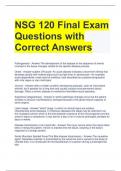Exam (elaborations)
NSG 120 Final Exam Questions with Correct Answers
- Course
- Institution
NSG 120 Final Exam Questions with Correct Answers Pathogenesis - Answer-The development of the disease or the sequence of events involved in the tissue changes related to the specific disease process. Onset - Answer-sudden OR acute- An acute disease indicates a short-term illness that develo...
[Show more]



